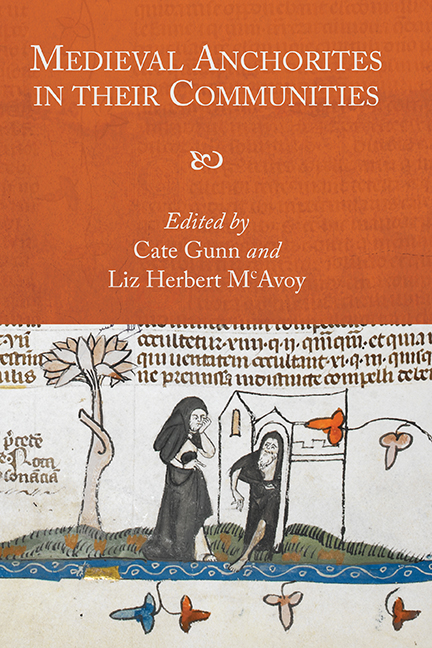Book contents
- Frontmatter
- Dedication
- Contents
- List of Illustrations
- Acknowledgements
- List of Contributors
- Abbreviations
- Introduction: ‘No Such Thing as Society?’ Solitude in Community
- 1 ‘O Sely Ankir!’
- Part I Religious Communities
- Part II Lay Communities
- 5 English Nuns as ‘Anchoritic Intercessors’ for Souls in Purgatory: The Employment of A Revelation of Purgatory by Late Medieval English Nunneries for Their Lay Communities
- 6 ‘In aniversaries of ower leoveste freond seggeth alle nihene’: Anchorites, Chantries and Purgatorial Patronage in Medieval England
- 7 ‘Item receyvyd of ye Anker’: The Relationships between a Parish and its Anchorites as Seen through the Churchwardens’ Accounts
- 8 The Curious Incident of the Hermit in Fisherton
- 9 Was Julian's Nightmare a Māre? Julian of Norwich and the Vernacular Community of Storytellers
- Part III Textual Communities
- Bibliography
- Index
- Miscellaneous Endmatter
5 - English Nuns as ‘Anchoritic Intercessors’ for Souls in Purgatory: The Employment of A Revelation of Purgatory by Late Medieval English Nunneries for Their Lay Communities
from Part II - Lay Communities
Published online by Cambridge University Press: 30 August 2017
- Frontmatter
- Dedication
- Contents
- List of Illustrations
- Acknowledgements
- List of Contributors
- Abbreviations
- Introduction: ‘No Such Thing as Society?’ Solitude in Community
- 1 ‘O Sely Ankir!’
- Part I Religious Communities
- Part II Lay Communities
- 5 English Nuns as ‘Anchoritic Intercessors’ for Souls in Purgatory: The Employment of A Revelation of Purgatory by Late Medieval English Nunneries for Their Lay Communities
- 6 ‘In aniversaries of ower leoveste freond seggeth alle nihene’: Anchorites, Chantries and Purgatorial Patronage in Medieval England
- 7 ‘Item receyvyd of ye Anker’: The Relationships between a Parish and its Anchorites as Seen through the Churchwardens’ Accounts
- 8 The Curious Incident of the Hermit in Fisherton
- 9 Was Julian's Nightmare a Māre? Julian of Norwich and the Vernacular Community of Storytellers
- Part III Textual Communities
- Bibliography
- Index
- Miscellaneous Endmatter
Summary
THE late-medieval Christian believed that after death souls entered purgatory to expiate their sins, and that the prayers of the living – especially of reputable devout men and women, such as anchorites and anchoresses – could significantly reduce the period of their suffering. The early fifteenth-century visionary text A Revelation of Purgatory promotes the intercessory powers of a woman recluse who intercedes for the release of a soul from purgatory. Scholars have identified the first woman as a Winchester anchoress and the second as a former nun of the Benedictine convent of St Mary, also known as Nunnaminster. An examination of hitherto unstudied manuscript and testamentary evidence, however, urges a re-consideration of this historical identification and suggests that the shared textual ancestor of the three extant copies of A Revelation – in Longleat House, MS 29 (c. 1425–50), Lincoln, Cathedral Library, MS 91 (c. 1430–40) and Oxford, Bodleian Library, MS Eng. th. c. 58 (possibly c. 1450–75) – may originate from an anonymous source, to which a scribe affiliated with Nunnaminster added local references in order to adapt the narrative for the convent. Consequently, these references may not reflect the work's historicity, but, rather, the work's historicisation. I suggest that neither the potential anonymous source nor the historicised version of A Revelation were tied to a single historical context but were, on the contrary, designed to be adapted to any number of local situations in which late-medieval convents interacted with their extramural lay communities. In such a context, A Revelation could cater to both religious women and the laity; the former could identify with the woman recluse and the latter, identifying with the purgatorial soul, could ask the ‘recluse’ to intercede for their souls in purgatory by organising masses. As we shall see, religious women customised and disseminated copies of the work in order to associate their institutions with ‘anchoritic intercessors’ and present these institutions as powerhouses of intercessory prayer. This enabled them to compete for and attract testators who would leave substantial bequests in return for their spiritual intercession.
Identifying A Revelation's ‘Anchoritic Intercessor’
A Revelation presents a three-part vision, experienced over three consecutive nights, beginning on 10 August 1422, in which an unnamed woman recluse tells of her encounter with the soul of Margaret, a deceased nun.
- Type
- Chapter
- Information
- Medieval Anchorites in their Communities , pp. 85 - 100Publisher: Boydell & BrewerPrint publication year: 2017



